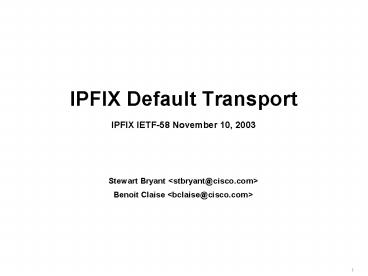IPFIX Default Transport IPFIX IETF-58 November 10, 2003 - PowerPoint PPT Presentation
Title:
IPFIX Default Transport IPFIX IETF-58 November 10, 2003
Description:
IPFIX needs to specify a default, TCP friendly transport protocol. ... HP-UX. Solaris. Linux. BSD. Windows. 11. 11. 11. IPFIX Transport IETF-58. Why not TCP? ... – PowerPoint PPT presentation
Number of Views:28
Avg rating:3.0/5.0
Title: IPFIX Default Transport IPFIX IETF-58 November 10, 2003
1
IPFIX Default TransportIPFIX IETF-58 November
10, 2003
- Stewart Bryant ltstbryant_at_cisco.comgt
- Benoit Claise ltbclaise_at_cisco.comgt
2
The Issue
- IPFIX needs to specify a default, TCP friendly
transport protocol. - TCP friendly IETF transports defined, or in late
stages of specification are TCP, SCTP, PR-SCTP
and DCCP. - Some members of the WG propose that we
standardise on TCP because it is ubiquitous. - Other members of the WG propose that we
standardise on PR-SCTP because its greater range
of functionality better addresses the spectrum of
IPFIX needs.
3
Why SCTP PR-SCTP
- Architecturally its the right protocol for the
job.
4
Best Fit to Architecture.
- SCTP with the PR-SCTP extensions
- Delivers reliable information just as TCP does.
- During uncongested periods, all the records
marked for deletion under congestion will be
reliably delivered. - During congested periods, the sender will begin
to drop packets to protect the network. - PR-SCTP therefore offers all the advantages of
TCP together with much of the flexibility of UDP,
and is at all times TCP-friendly.
5
PR-SCTP Flexibility
PR-SCTP allows the IPFIX application the
flexibility to use reliable, partially reliable
and unreliable, over one association with
multiple streams. For example some Options
Template reporting and some metering info might
use the reliable stream while the Data Records
would use the partially reliable stream.
6
Availability promotes use
- Choosing PR-SCTP as the default protocol means
that PR-SCTP will be available to all exporters
and collectors. - quicker failover
- multihoming
- These would otherwise have to be constructed at
applications level.
7
PR-SCTP availability
"PR-SCTP is not deployed widely enough to be
considered a default for any IETF technology."
There are about 20 implementations for
SCTP. PR-SCTP is an extension of SCTP which is
available. PR-SCTP may not yet be there in all
of the implementations, but that is not a problem
either since if you don't have PR-SCTP then you
end up with basic SCTP with full reliability,
which is no different than TCP.
8
We need a Transport with an RFC
"The default transport for a standards track
protocol should at least be an RFC. " RFC
PR-SCTP finished TSVWG last call quite some time
ago, and will go to IESG last call as soon as the
AD review phase is complete. This will happen
shortly. PR-SCTP will be an RFC long before
IPFIX.
9
Weaning the Internet off UDP
Ultimately the IPFIX RFC is only a guide. The
customer will specify the system they need for
their business, and vendors will build them.
UDP is available today for export and demand
for this is likely to continue. UDP is a very
low overhead protocol and is available on ALL
platforms under consideration. The IETF needs to
migrate users away from UDP and SCTP better
provides better prospect for this than TCP.
10
Availability
- Assertion "SCTP is not widely implemented"
- SCTP is available on
- HP-UX
- Solaris
- Linux
- BSD
- Windows
11
Why not TCP?
- TCP has a single mode - reliable congestion
aware. - Partial reliability has to be synthesised in the
application. - By the time you have the code to do this
synthesis, you have implemented an inferior
version of SCTP in the application.































